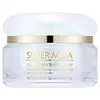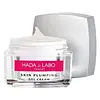What's inside
What's inside
 Key Ingredients
Key Ingredients

 Benefits
Benefits

 Concerns
Concerns

 Ingredients Side-by-side
Ingredients Side-by-side

Snail Secretion Filtrate
Skin ConditioningDimethicone
EmollientGlycerin
HumectantAlcohol
AntimicrobialAdansonia Digitata Seed Extract
Skin ConditioningArbutin
AntioxidantBis-PEG-18 Methyl Ether Dimethyl Silane
EmollientPEG-11 Methyl Ether Dimethicone
EmulsifyingSea Water
HumectantEthylhexyl Isononanoate
EmollientHydroxyethyl Acrylate/Sodium Acryloyldimethyl Taurate Copolymer
Emulsion StabilisingPortulaca Oleracea Extract
Skin ConditioningCarbomer
Emulsion StabilisingTriethanolamine
BufferingPEG-40 Hydrogenated Castor Oil
EmulsifyingPPG-26-Buteth-26
Skin ConditioningCaprylyl Glycol
EmollientParfum
MaskingEthylhexylglycerin
Skin ConditioningTocopheryl Acetate
AntioxidantAdenosine
Skin ConditioningDisodium EDTA
Centella Asiatica Meristem Cell Culture
AntioxidantXanthan Gum
EmulsifyingSnail Secretion Filtrate, Dimethicone, Glycerin, Alcohol, Adansonia Digitata Seed Extract, Arbutin, Bis-PEG-18 Methyl Ether Dimethyl Silane, PEG-11 Methyl Ether Dimethicone, Sea Water, Ethylhexyl Isononanoate, Hydroxyethyl Acrylate/Sodium Acryloyldimethyl Taurate Copolymer, Portulaca Oleracea Extract, Carbomer, Triethanolamine, PEG-40 Hydrogenated Castor Oil, PPG-26-Buteth-26, Caprylyl Glycol, Parfum, Ethylhexylglycerin, Tocopheryl Acetate, Adenosine, Disodium EDTA, Centella Asiatica Meristem Cell Culture, Xanthan Gum
Water
Skin ConditioningButylene Glycol
HumectantGlycerin
HumectantHydroxyethyl Urea
HumectantPentylene Glycol
Skin ConditioningPPG-10 Methyl Glucose Ether
Skin ConditioningTriethylhexanoin
MaskingSqualane
EmollientDimethicone
EmollientAmmonium Acryloyldimethyltaurate/Vp Copolymer
PPG-17-Buteth-17
Skin ConditioningTriethyl Citrate
MaskingBehenyl Alcohol
EmollientPhenoxyethanol
PreservativePropanediol
SolventSodium Citrate
BufferingSodium Hyaluronate
HumectantXanthan Gum
EmulsifyingDisodium EDTA
Citric Acid
BufferingCaprylhydroxamic Acid
Hydrolyzed Hyaluronic Acid
HumectantSodium Acetylated Hyaluronate
HumectantTocopherol
AntioxidantLecithin
EmollientAscorbyl Palmitate
AntioxidantHydrolyzed Collagen
EmollientHydrogenated Vegetable Glycerides Citrate
EmollientAphanothece Sacrum Polysaccharide
AbsorbentAlcohol Denat.
AntimicrobialHydroxypropyltrimonium Hyaluronate
Phospholipids
Skin ConditioningPotassium Sorbate
PreservativeSphingolipids
EmollientBenzoic Acid
MaskingSorbic Acid
PreservativeWater, Butylene Glycol, Glycerin, Hydroxyethyl Urea, Pentylene Glycol, PPG-10 Methyl Glucose Ether, Triethylhexanoin, Squalane, Dimethicone, Ammonium Acryloyldimethyltaurate/Vp Copolymer, PPG-17-Buteth-17, Triethyl Citrate, Behenyl Alcohol, Phenoxyethanol, Propanediol, Sodium Citrate, Sodium Hyaluronate, Xanthan Gum, Disodium EDTA, Citric Acid, Caprylhydroxamic Acid, Hydrolyzed Hyaluronic Acid, Sodium Acetylated Hyaluronate, Tocopherol, Lecithin, Ascorbyl Palmitate, Hydrolyzed Collagen, Hydrogenated Vegetable Glycerides Citrate, Aphanothece Sacrum Polysaccharide, Alcohol Denat., Hydroxypropyltrimonium Hyaluronate, Phospholipids, Potassium Sorbate, Sphingolipids, Benzoic Acid, Sorbic Acid
 Reviews
Reviews

Ingredients Explained
These ingredients are found in both products.
Ingredients higher up in an ingredient list are typically present in a larger amount.
Dimethicone is a type of synthetic silicone created from natural materials such as quartz.
What it does:
Dimethicone comes in different viscosities:
Depending on the viscosity, dimethicone has different properties.
Ingredients lists don't always show which type is used, so we recommend reaching out to the brand if you have questions about the viscosity.
This ingredient is unlikely to cause irritation because it does not get absorbed into skin. However, people with silicone allergies should be careful about using this ingredient.
Note: Dimethicone may contribute to pilling. This is because it is not oil or water soluble, so pilling may occur when layered with products. When mixed with heavy oils in a formula, the outcome is also quite greasy.
Learn more about DimethiconeDisodium EDTA plays a role in making products more stable by aiding other preservatives.
It is a chelating agent, meaning it neutralizes metal ions that may be found in a product.
Disodium EDTA is a salt of edetic acid and is found to be safe in cosmetic ingredients.
Learn more about Disodium EDTAGlycerin is already naturally found in your skin. It helps moisturize and protect your skin.
A study from 2016 found glycerin to be more effective as a humectant than AHAs and hyaluronic acid.
As a humectant, it helps the skin stay hydrated by pulling moisture to your skin. The low molecular weight of glycerin allows it to pull moisture into the deeper layers of your skin.
Hydrated skin improves your skin barrier; Your skin barrier helps protect against irritants and bacteria.
Glycerin has also been found to have antimicrobial and antiviral properties. Due to these properties, glycerin is often used in wound and burn treatments.
In cosmetics, glycerin is usually derived from plants such as soybean or palm. However, it can also be sourced from animals, such as tallow or animal fat.
This ingredient is organic, colorless, odorless, and non-toxic.
Glycerin is the name for this ingredient in American English. British English uses Glycerol/Glycerine.
Learn more about GlycerinXanthan gum is used as a stabilizer and thickener within cosmetic products. It helps give products a sticky, thick feeling - preventing them from being too runny.
On the technical side of things, xanthan gum is a polysaccharide - a combination consisting of multiple sugar molecules bonded together.
Xanthan gum is a pretty common and great ingredient. It is a natural, non-toxic, non-irritating ingredient that is also commonly used in food products.
Learn more about Xanthan Gum